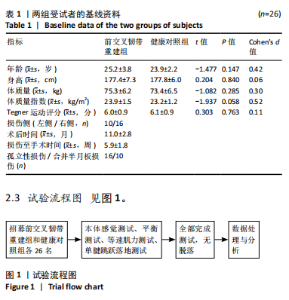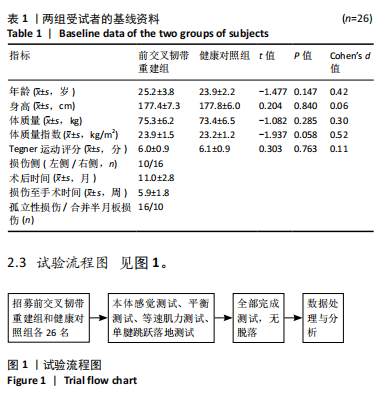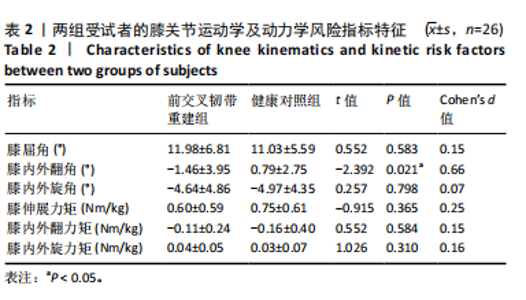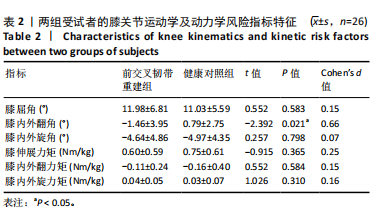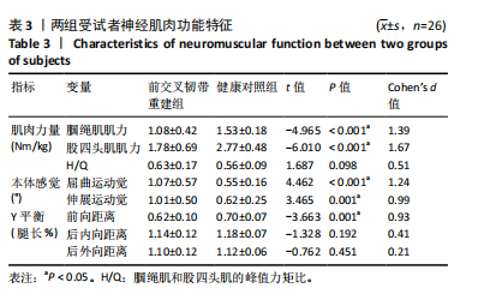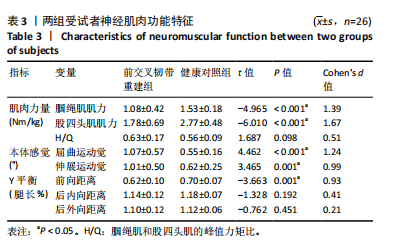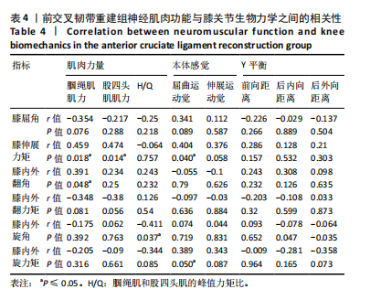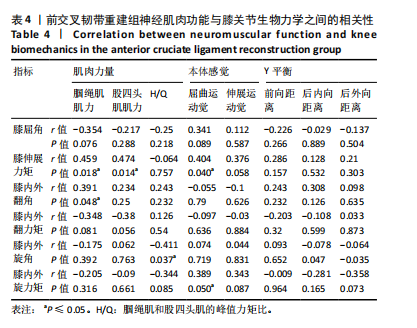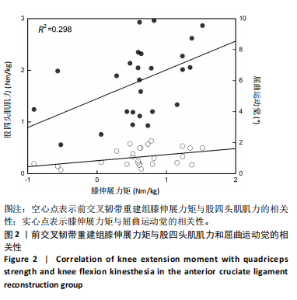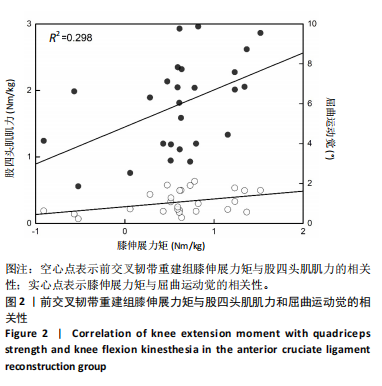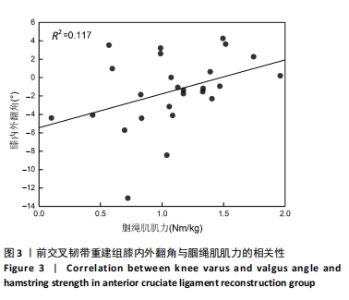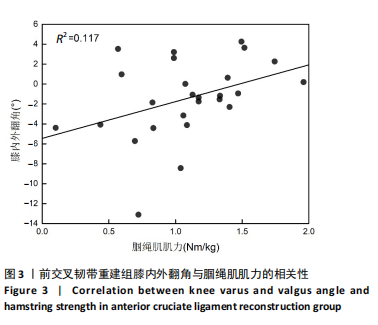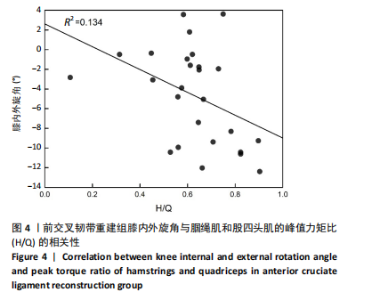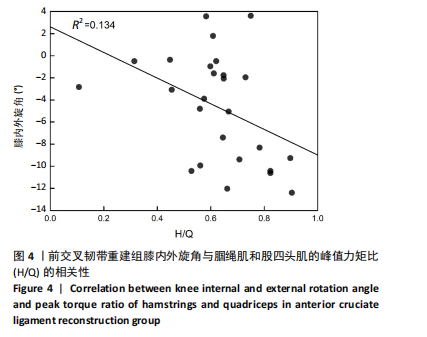Chinese Journal of Tissue Engineering Research ›› 2025, Vol. 29 ›› Issue (26): 5556-5562.doi: 10.12307/2025.782
Previous Articles Next Articles
Influence of neuromuscular function on the risk of biomechanical injury in landing manoeuvres in patients undergoing anterior cruciate ligament reconstruction
Wang Xia1, Xue Boshi1, Yang Chen2, Zhou Zhipeng1, Zheng Liangliang1
- 1College of Sports and Health, Shandong Sport University, Jinan 250102, Shandong Province, China; 2College of Sports and Health, Nanjing Sport Institute, Nanjing 210114, Jiangsu Province, China
-
Received:2024-09-20Accepted:2024-11-13Online:2025-09-18Published:2025-02-22 -
Contact:Zheng Liangliang, MS, Associate professor, College of Sports and Health, Shandong Sport University, Jinan 250102, Shandong Province, China -
About author:Wang Xia, Master candidate, College of Sports and Health, Shandong Sport University, Jinan 250102, Shandong Province, China -
Supported by:Shandong Province College Youth Entrepreneurship Talent Introduction and Cultivation Program, No. 2019-183 (to ZZP)
CLC Number:
Cite this article
Wang Xia, Xue Boshi, Yang Chen, Zhou Zhipeng, Zheng Liangliang. Influence of neuromuscular function on the risk of biomechanical injury in landing manoeuvres in patients undergoing anterior cruciate ligament reconstruction[J]. Chinese Journal of Tissue Engineering Research, 2025, 29(26): 5556-5562.
share this article
Add to citation manager EndNote|Reference Manager|ProCite|BibTeX|RefWorks
| [1] MONTALVO AM, SCHNEIDER DK, WEBSTER KE, et al. Anterior Cruciate Ligament Injury Risk in Sport: A Systematic Review and Meta-Analysis of Injury Incidence by Sex and Sport Classification. J Athl Train. 2019; 54(5):472-482. [2] ZHANG L, HACKE JD, GARRETT WE, et al. Bone Bruises Associated with Anterior Cruciate Ligament Injury as Indicators of Injury Mechanism: A Systematic Review. Sports Med. 2019;49(3):453-462. [3] SHIMOKOCHI Y, SHULTZ SJ. Mechanisms of noncontact anterior cruciate ligament injury. J Athl Train. 2008;43(4):396-408. [4] LI RT, LORENZ S, XU Y, et al. Predictors of radiographic knee osteoarthritis after anterior cruciate ligament reconstruction. Am J Sports Med. 2011;39(12):2595-2603. [5] PASCHOS NK, HOWELL SM. Anterior cruciate ligament reconstruction: principles of treatment. EFORT Open Rev. 2017;1(11):398-408. [6] WIGGINS AJ, GRANDHI RK, SCHNEIDER DK, et al. Risk of Secondary Injury in Younger Athletes After Anterior Cruciate Ligament Reconstruction: A Systematic Review and Meta-analysis. Am J Sports Med. 2016;44(7):1861-1876. [7] BARBER-WESTIN S, NOYES FR. One in 5 Athletes Sustain Reinjury Upon Return to High-Risk Sports After ACL Reconstruction: A Systematic Review in 1239 Athletes Younger Than 20 Years. Sports Health. 2020; 12(6):587-597. [8] 刘卉,苏玉林,于冰.非接触性前交叉韧带损伤特点及机制的研究进展[J].医用生物力学,2008,23(3):240-247. [9] 张玲,蔡宗远,王少白,等.前交叉韧带重建术后膝关节运动分析研究进展[J].医用生物力学,2020,35(2):240-246. [10] DAI B, HERMAN D, LIU H, et al. Prevention of ACL injury, part I: injury characteristics, risk factors, and loading mechanism. Res Sports Med. 2012;20(3-4):180-197. [11] 刘卉,张美珍,李翰君,等.足球运动员在急停起跳和侧切动作中前交叉韧带损伤的生物力学特征研究[J].体育科学,2011,31(12): 38-43. [12] MIYASAKA T, MATSUMOTO H, SUDA Y, et al. Coordination of the anterior and posterior cruciate ligaments in constraining the varus-valgus and internal-external rotatory instability of the knee. J Orthop Sci. 2002;7(3):348-353. [13] HEWETT TE, MYER GD, FORD KR, et al. Biomechanical measures of neuromuscular control and valgus loading of the knee predict anterior cruciate ligament injury risk in female athletes: a prospective study. Am J Sports Med. 2005;33(4):492-501. [14] YANG C, TASHIRO Y, LYNCH A, et al. Kinematics and arthrokinematics in the chronic ACL-deficient knee are altered even in the absence of instability symptoms. Knee Surg Sports Traumatol Arthrosc. 2018; 26(5):1406-1413. [15] DELLA VILLA F, STRAUB RK, MANDELBAUM B, et al. Confidence to Return to Play After Anterior Cruciate Ligament Reconstruction Is Influenced by Quadriceps Strength Symmetry and Injury Mechanism. Sports Health. 2021;13(3):304-309. [16] 程凯.前交叉韧带自体腘绳肌腱重建术后重返运动相关因素分析[D].济南:山东大学,2021. [17] 曾宗良.南宁市城区夜跑爱好者运动参与的调查研究[D].南宁:广西民族大学,2022. [18] NIEDERER D, KELLER M, ACHTNICH A, et al. Effectiveness of a home-based re-injury prevention program on motor control, return to sport and recurrence rates after anterior cruciate ligament reconstruction: study protocol for a multicenter, single-blind, randomized controlled trial (PReP). Trials. 2019;20(1):495. [19] 马晓丽,马小远,宋祺鹏.高运动需求者前交叉韧带重建术后不同时期的肌肉力量、本体感觉和足底触觉与重返运动的相关性研究[J].中国康复医学杂志,2023,38(9):1207-1213. [20] JAFFRI AH, SALIBA S. Does verbal encouragement change dynamic balance? The effect of verbal encouragement on Star Excursion Balance Test performance in chronic ankle Instability. Braz J Phys Ther. 2021;25(5):617-622. [21] KIM H, SON S, SEELEY MK, et al. Functional Fatigue Alters Lower-extremity Neuromechanics during a Forward-side Jump. Int J Sports Med. 2015;36(14):1192-1200. [22] TENG PSP, KONG PW, LEONG KF. Effects of foot rotation positions on knee valgus during single-leg drop landing: Implications for ACL injury risk reduction. Knee. 2017;24(3):547-554. [23] WALSH M, BOLING MC, MCGRATH M, et al. Lower extremity muscle activation and knee flexion during a jump-landing task. J Athl Train. 2012;47(4):406-413. [24] 张美珍.非接触性前交叉韧带损伤危险因素的生物力学研究[D].北京:北京体育大学,2012. [25] 李翰君,刘卉,张美珍,等.确定前交叉韧带损伤概率及危险因素的随机生物力学模型与模拟[J].体育科学,2014,34(12):37-43. [26] WU G, SIEGLER S, ALLARD P, et al. ISB recommendation on definitions of joint coordinate system of various joints for the reporting of human joint motion--part I: ankle, hip, and spine. International Society of Biomechanics. J Biomech. 2002;35(4):543-548. [27] COHEN J. A power primer. Psychol Bull. 1992;112(1):155-159. [28] COHEN J. Statistical power analysis for the behavioral sciences. Hoboken, NJ: Taylor and Francis, 2013. [29] 刘晓磊,张鸿悦,章耀华.前交叉韧带重建术后患者膝本体感觉与姿势控制的相关性[J].中国康复,2021,36(3):170-173. [30] STAPLES JR, SCHAFER KA, SMITH MV, et al. Decreased Postural Control in Patients Undergoing Anterior Cruciate Ligament Reconstruction Compared to Healthy Controls. J Sport Rehabil. 2019;29(7):920-925. [31] HOCH JM, PERKINS WO, HARTMAN JR, et al. Somatosensory deficits in post-ACL reconstruction patients: A case-control study. Muscle Nerve. 2017;55(1):5-8. [32] 王玲,姜霞,陈鹏,等.前交叉韧带重建患者双腿垂直跳跃期间的下肢生物力学特征[J].中国组织工程研究,2024,28(14):2215-2220. [33] 任爽,时会娟,梁子轩,等.前交叉韧带重建术后侧切动作的生物力学特征[J].北京大学学报(医学版),2024,56(5):868-873. [34] BELOZO FL, BELOZO RSMN, RICARDO LOPES C, et al. Anterior cruciate ligament: A brief narrative review of main risk factors for injury and re-injury. J Bodyw Mov Ther. 2024;38:92-99. [35] HEWETT TE, STROUPE AL, NANCE TA, et al. Plyometric training in female athletes. Decreased impact forces and increased hamstring torques. Am J Sports Med. 1996;24(6):765-773. [36] CARAFFA A, CERULLI G, PROJETTI M, et al. Prevention of anterior cruciate ligament injuries in soccer. A prospective controlled study of proprioceptive training. Knee Surg Sports Traumatol Arthrosc. 1996;4(1):19-21. [37] CLAIBORNE TL, ARMSTRONG CW, GANDHI V, et al. Relationship between hip and knee strength and knee valgus during a single leg squat. J Appl Biomech. 2006;22(1):41-50. [38] 周志鹏.神经肌肉功能与前交叉韧带损伤生物力学危险因素的相关性研究[D].北京:北京体育大学,2018. [39] NILSTAD A, KROSSHAUG T, MOK KM, et al. Association Between Anatomical Characteristics, Knee Laxity, Muscle Strength, and Peak Knee Valgus During Vertical Drop-Jump Landings. J Orthop Sports Phys Ther. 2015;45(12):998-1005. [40] MARKOLF KL, GRAFF-RADFORD A, AMSTUTZ HC. In vivo knee stability. A quantitative assessment using an instrumented clinical testing apparatus. J Bone Joint Surg Am. 1978;60(5):664-674. [41] CHEUNG VCK, SEKI K. Approaches to revealing the neural basis of muscle synergies: a review and a critique. J Neurophysiol. 2021; 125(5):1580-1597. [42] PATEL NK, SABHARWAL S, HADLEY C, et al. Factors affecting return to sport following hamstrings anterior cruciate ligament reconstruction in non-elite athletes. Eur J Orthop Surg Traumatol. 2019;29(8):1771-1779. [43] KYRITSIS P, BAHR R, LANDREAU P, et al. Likelihood of ACL graft rupture: not meeting six clinical discharge criteria before return to sport is associated with a four times greater risk of rupture. Br J Sports Med. 2016;50(15):946-951. [44] LEPHART SM, FERRIS CM, RIEMANN BL, et al. Gender differences in strength and lower extremity kinematics during landing. Clin Orthop Relat Res. 2002;(401):162-169. [45] SHULTZ SJ, NGUYEN AD, LEONARD MD, et al. Thigh strength and activation as predictors of knee biomechanics during a drop jump task. Med Sci Sports Exerc. 2009;41(4):857-866. |
| [1] | Zhang Zixian, Xu Youliang, Wu Shaokui, Wang Xiangying. Effects of blood flow restriction training combined with resistance training on muscle indicators in college athletes: a meta-analysis [J]. Chinese Journal of Tissue Engineering Research, 2025, 29(8): 1705-1713. |
| [2] | Wang Juan, Wang Guanglan, Zuo Huiwu. Efficacy of exercise therapy in the treatment of anterior cruciate ligament reconstruction patients: #br# a network meta-analysis #br# [J]. Chinese Journal of Tissue Engineering Research, 2025, 29(8): 1714-1726. |
| [3] | Wu Yihan, Liu Zhongqiang, Wei Qiaoye, Liu Mingdong, Chen Keyi, Li Zhigang. Effect of balance training with different visual conditions on proprioception in patients with chronic ankle instability [J]. Chinese Journal of Tissue Engineering Research, 2025, 29(5): 1050-1057. |
| [4] | Yan Laijun, Ge Haiya, Wang Zhengming, Yang Zongrui, Niu Lifeng, Zhan Hongsheng. Mechanism by which Tongdu Huoxue Decoction inhibits macrophage inflammation to delay intervertebral disc degeneration in rats [J]. Chinese Journal of Tissue Engineering Research, 2025, 29(32): 6851-6857. |
| [5] | Nigeayi · Aihemaiti, Yilidanna · Dilixiati, An Wei, Maimaitituxun · Tuerdi. Expression of mitochondrial creatine kinase 2 in a rat model of temporomandibular joint osteoarthritis and its role in inflammation progression [J]. Chinese Journal of Tissue Engineering Research, 2025, 29(32): 6877-6884. |
| [6] | Wang Ziheng, Wu Shuang. Oxidative stress-related genes and molecular mechanisms after spinal cord injury: data analysis and verification based on GEO database [J]. Chinese Journal of Tissue Engineering Research, 2025, 29(32): 6893-6904. |
| [7] | Lu Xiuli, Xu Huazhen, Chen Yuxing, Yao Nan, Hu Zixuan, Huang Dane. Mechanism of Jiangu Formula in treating osteoporosis based on osteoclast-osteoblast coupling [J]. Chinese Journal of Tissue Engineering Research, 2025, 29(32): 6828-6835. |
| [8] | Yu Qinghe, Cai Ziming, Wu Jintao, Ma Pengfei, Zhang Xin, Zhou Longqian, Wang Yakun, Lin Xiaoqin, Lin Wenping. Vanillic acid inhibits inflammatory response and extracellular matrix degradation of endplate chondrocytes [J]. Chinese Journal of Tissue Engineering Research, 2025, 29(30): 6391-9397. |
| [9] | Fan Jiaxin, Jia Xiang, Xu Tianjie, Liu Kainan, Guo Xiaoling, Zhang Hui, Wang Qian . Metformin inhibits ferroptosis and improves cartilage damage in osteoarthritis model rats [J]. Chinese Journal of Tissue Engineering Research, 2025, 29(30): 6398-6408. |
| [10] | Zhou Ying, Tian Yong, Zhong Zhimei, Gu Yongxiang, Fang Hao. Inhibition of tumor necrosis factor receptor associated factor 6 regulates mTORC1/ULK1 signaling and promotes autophagy to improve myocardial injury in sepsis mice [J]. Chinese Journal of Tissue Engineering Research, 2025, 29(30): 6434-6440. |
| [11] | Wang Wanchun, , Yi Jun, Yan Zhangren, Yang Yue, Dong Degang, Li Yumei. 717 Jiedu Decoction remodels homeostasis of extracellular matrix and promotes repair of local injured tissues in rats after Agkistrodon halys bite [J]. Chinese Journal of Tissue Engineering Research, 2025, 29(30): 6457-6465. |
| [12] | Zhang Xin, Guo Baojuan, Xu Huixin, Shen Yuzhen, Yang Xiaofan, Yang Xufang, Chen Pei. Protective effects and mechanisms of 3-N-butylphthalide in Parkinson’s disease cell models [J]. Chinese Journal of Tissue Engineering Research, 2025, 29(30): 6466-6473. |
| [13] | Zhang Songjiang, Li Longyang, Zhou Chunguang, Gao Jianfeng. Central anti-inflammatory effect and mechanism of tea polyphenols in exercise fatigue model mice [J]. Chinese Journal of Tissue Engineering Research, 2025, 29(30): 6474-6481. |
| [14] | Hu Shujuan, Liu Dang, Ding Yiting, Liu Xuan, Xia Ruohan, Wang Xianwang. Ameliorative effect of walnut oil and peanut oil on atherosclerosis [J]. Chinese Journal of Tissue Engineering Research, 2025, 29(30): 6482-6488. |
| [15] | Zhang Jian, Cai Feng, Li Tingwen, Ren Pengbo. Fatigue gait recognition of athletes based on fish swarm algorithm [J]. Chinese Journal of Tissue Engineering Research, 2025, 29(30): 6489-6498. |
| Viewed | ||||||
|
Full text |
|
|||||
|
Abstract |
|
|||||
